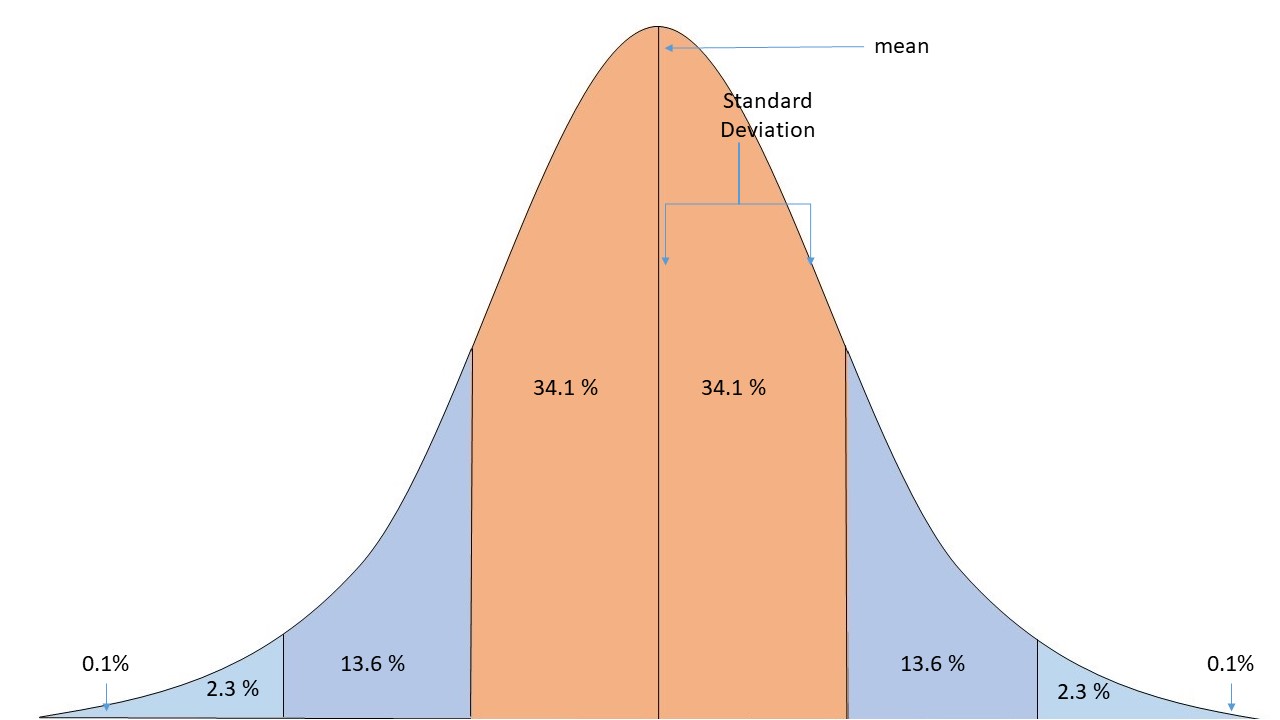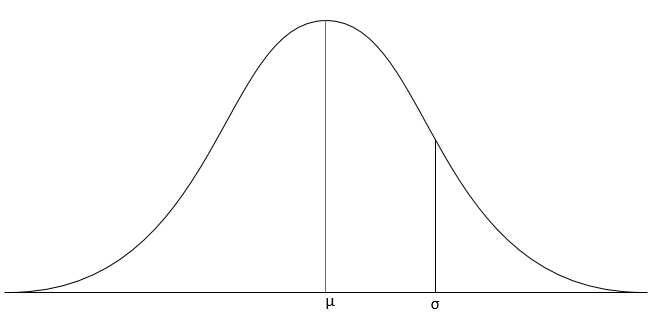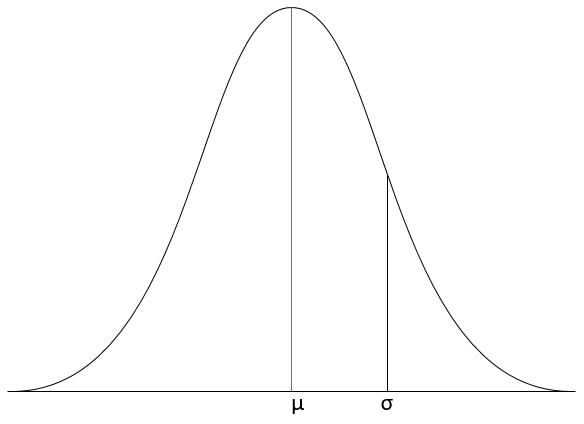In measures of dispersion, the standard deviation is one of the prominent tools to calculate the dispersion of the data
Standard Deviation

In measures of dispersion, the standard deviation is one of the prominent tools to calculate the dispersion of the data. The purpose of standard deviation is to calculate the deviation of data from the mean of the data. We first calculate the mean of the data, then we sum up the squared difference of each point from the mean.
Simple Data
Let’s directly start with an example of a simple series
34 34 40 43 45 46 48 46
The formula for a standard deviation for Simple Series is as follows, σ is Standard Deviation.
Standard Deviation Formula

In this equation,
N is the number of items in a series, d2 is the Squared differences of items from the series mean
| x | d=| x – μ | | d2 |
|---|---|---|
| 34 | 8.5 | 72.25 |
| 38 | 4.5 | 20.25 |
| 40 | 2.5 | 6.25 |
| 43 | 0.5 | 0.25 |
| 45 | 2.5 | 6.25 |
| 46 | 3.5 | 12.25 |
| 48 | 5.5 | 30.25 |
| 46 | 3.5 | 12.25 |
| Σx=340 , μ = 42.5 | Σd2= 160 |

From the above example, we get an idea of how the standard deviation works in theory and practice. As this is a simple series of data, we directly calculated the difference and deviations.
Although, we also face datasets of multiple types, like continuous and discrete series.
Discrete Data
The series below is a discrete series. This type of data can be explained with x as the value or price and f as the frequency of x’s occurrence.
Let’s say x is the value of an item ordered from a grocery store, and f will be how many units of item x are ordered.
The apples cost $60, and there are 250 apples. So the fx will be, 15000
| χ | ƒ |
| 60 | 250 |
| 62 | 300 |
| 64 | 410 |
| 66 | 500 |
| 67 | 350 |
| 68 | 275 |
| 69 | 150 |
| 70 | 100 |
| 71 | 25 |
| f=2360 |

The calculations in this table for standard derivation are slightly different from the simple series. But the root of the formula is still the same.
| χ | ƒ | ƒχ | d=| χ – μ | | d2 | ƒd2 |
|---|---|---|---|---|---|
| 60 | 250 | 15000 | 5.3 | 28.09 | 7022.5 |
| 62 | 300 | 18600 | 3.3 | 10.89 | 3267 |
| 64 | 410 | 26240 | 1.3 | 1.69 | 692.9 |
| 66 | 500 | 33000 | 0.7 | 0.49 | 245 |
| 67 | 350 | 23450 | 1.7 | 2.89 | 1011.5 |
| 68 | 275 | 18700 | 2.7 | 7.29 | 2004.75 |
| 69 | 150 | 10350 | 3.7 | 13.69 | 2053.5 |
| 70 | 100 | 7000 | 4.7 | 22.09 | 2209 |
| 71 | 25 | 1775 | 5.7 | 32.49 | 812.25 |
| Σƒ=2360 | Σƒχ=154115 | Σƒd2=19318.4 |

Continuous Data
Let’s learn to calculate standard deviation from continuous data. In the following example, we will take a sample of continuous data and apply the standard deviation formula on it.
An example of continuous data can be stocks of a company throughout each month of a year, or the average/cumulative weight of students in a class.
The following example of Classes of IQs and f is the number of students in those classes of IQs
| Class | F |
|---|---|
| 40-50 | 11 |
| 50-60 | 23 |
| 60-70 | 40 |
| 70-80 | 60 |
| 80-90 | 35 |
| 90-100 | 16 |
| 100-110 | 09 |
| 110-120 | 06 |
The formulae for standard deviation are

The First Equation calculates the mean of the series.
The second equation calculates the difference between series and mean.
The third equation calculates standard deviation.
| Class | Frequency f | Mid-value m | fm | d=|m-μ | μ=74.95 | d2 | fd2 |
|---|---|---|---|---|---|---|
| 40-50 | 11 | 45 | 495 | 29.95 | 897 | 9867 |
| 50-60 | 23 | 55 | 1265 | 19.95 | 398 | 9154 |
| 60-70 | 40 | 65 | 2600 | 9.95 | 99 | 3960 |
| 70-80 | 60 | 75 | 4500 | 0.05 | 0.0025 | 0.15 |
| 80-90 | 35 | 85 | 2975 | 10.05 | 101 | 3515 |
| 90-100 | 16 | 95 | 1520 | 20.05 | 402 | 6432 |
| 100-110 | 09 | 105 | 945 | 30.05 | 903 | 8127 |
| 110-120 | 06 | 115 | 690 | 40.05 | 1604 | 9624 |
| Σƒ=200 | Σƒm=14990 | Σƒd2=50699.15 |


From the above calculation we get that average IQ of all students is 74.95, and we get the standard deviation from IQ
If you are still wondering, what will we get from calculating? We can find the spread of the data by comparing the difference between the mean and standard deviation.
Let’s see how the widespread and densely populated data would look.


ANCOVA: Analysis of Covariance with python
ANCOVA is an extension of ANOVA (Analysis of Variance) that combines blocks of regression analysis and ANOVA. Which makes it Analysis of Covariance.
Learn Python The Fun Way
What if we learn topics in a desirable way!! What if we learn to write Python codes from gamers data !!
Meet the most efficient and intelligent AI assistant : NotebookLM
Start using NotebookLM today and embark on a smarter, more efficient learning journey!
Break the ice
This can be a super guide for you to start and excel in your data science career.
Manova Quiz
Solve this quiz for testing Manova Basics
Quiz on Group By
Test your knowledge on pandas groupby with this quiz
Visualization Quiz
Observe the dataset and try to solve the Visualization quiz on it
Versions of ANCOVA (Analysis Of Covariance) with python
To perform ANCOVA (Analysis of Covariance) with a dataset that includes multiple types of variables, you’ll need to ensure your dependent variable is continuous, and you can include categorical variables as factors. Below is an example using the statsmodels library in Python: Mock Dataset Let’s create a dataset with a mix of variable types: Performing…
Python Variables
How useful was this post? Click on a star to rate it! Submit Rating
A/B Testing Quiz
Complete the code by dragging and dropping the correct functions
Python Functions
Python functions are a vital concept in programming which enables you to group and define a collection of instructions. This makes your code more organized, modular, and easier to understand and maintain. Defining a Function: In Python, you can define a function via the def keyword, followed by the function name, any parameters wrapped in parentheses,…
Python Indexing: A Guide for Data Science Beginners
Mastering indexing will significantly boost your data manipulation and analysis skills, a crucial step in your data science journey.
Diffusion Models: Making AI Creativity
Stable Diffusion Models: Where Art and AI Collide Artificial Intelligence meets creativity in the fascinating realm of Stable Diffusion Models. These innovative models take text descriptions and bring them to life in the form of detailed and realistic images. Let’s embark on a journey to understand the magic behind Stable Diffusion in a way that’s…
Points You Earned


Leave a Reply
You must be logged in to post a comment.